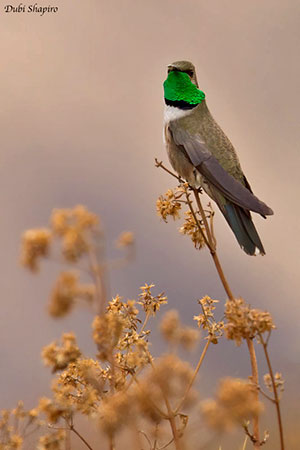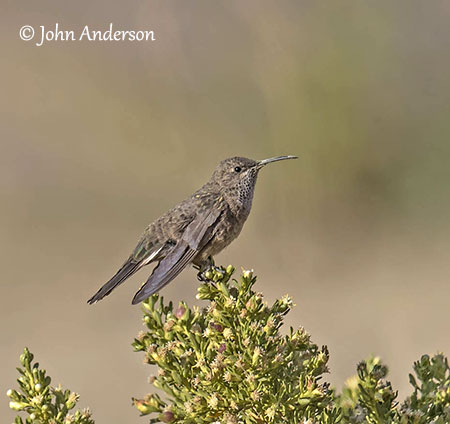
The Andean Hillstar male moves around in grasslands while the female performs alone all the nesting duties.
The birds may disperse to adjacent warmer areas during the southern winter.
This species hovers less than other hummingbirds and only performs short-distance flights.
REPRODUCTION OF THIS SPECIES:
The breeding season takes place between September and February.
The territory is held and defended by the female. It is established in gorges where bushes are growing among rocks.
The nest is a bulky structure, a large cup-shaped nest glued to a rock surface or under an overhanging rock. It is usually made with moss and lichen held together with spider webs. This well-insulated structure is often placed on the eastern face of rocks to catch the morning sun. It may also be built in a shallow cave.
In very suitable locations, several females may nest semi-colonially.
The female lays two eggs and incubates alone during 20 days. She feeds the chicks alone and the young fledge about 38 days after hatching, or less in warmer places. A second clutch is sometimes possible.
The young birds are fully fledged at about fine weeks old. During this period, the male moves out to live at higher elevation.
PROTECTION / THREATS / STATUS:
The Andean Hillstar is described as the “commonest puna bird” although it is less common in areas where plant diversity is reduced by overgrazing and traditional fires. However, the species is present in several protected areas.
The size of the population is unknown, but it is suspected to be stable.
The Andean Hillstar is not globally threatened and currently evaluated as Least Concern.
Fr: Colibri d’Estelle – Colibri Estelle
Ang: Andean Hillstar
All: Estella-Andenkolibri
Esp: Colibrí puneño - Estrella Andina
Ita: Orostella delle Ande
Nd: Estellabergnimf
Sd: punabergstjärna
Photographers:
John Anderson
John Anderson Photo Galleries
Dubi Shapiro
Dubi Shapiro Photo Galleries
Text by Nicole Bouglouan
Sources:
HANDBOOK OF THE BIRDS OF THE WORLD Vol 5 by Josep del Hoyo-Andrew Elliott-Jordi Sargatal - Lynx Edicions - ISBN: 8487334253
Birds of Ecuador De Robin Restall, Juan Freile – Editeur: Bloomsbury Publishing, 2019 – ISBN: 147297249X, 9781472972491 - 576 pages
Nature Guide Birds of the World De DK – Editeur: Dorling Kindersley Ltd, 2012 – ISBN: 1409375471, 9781409375470 – 352 pages
A Wildlife Guide to Chile: Continental Chile, Chilean Antarctica, Easter ... De Sharon Chester – Editeur: Princeton University Press, 2010 – ISBN: 1400831504, 9781400831500 – 400 pages
BIRDS OF PERU by Thomas S. Schulenberg, Douglas F. Stotz, Daniel F. Lane, John P. O’Neill, Theodore A. Parker III – Princeton University Press 2007– ISBN: 978-0-691-13023-1
Arthur Grosset's Birds (Arthur Grosset)
Wikipedia, the free encyclopaedia
Wikipedia, la enciclopedia libre
Andean Hillstar
Oreotrochilus estella
Apodiformes Order – Trochilidae Family
INTRODUCTION:
Like other Oreotrochilus species, the Andean Hillstar lives in puna grasslands, especially around rocky crops at high elevation in the central plateau of the Andes. It is found from SW Peru, through W Bolivia and N Chile to NW Argentina. Two subspecies share this range.
It feeds on nectar from flowers of Chuquiragua spinosa and other plant species. It nests in a large structure built under overhanging rocks or glued to a rock surface, sometimes in caves.
Like other hillstars, it feeds by clinging to branches instead of hovering. During the cold nights, it enters a state of torpor to survive and conserve energy.
Within the pairs, the territorial roles are reversed. The female holds and defends the breeding territory, and she also raises the chicks alone while the male moves to higher elevations.
The Andean Hillstar is not globally threatened and the population is currently stable.
The name of this species pays tribute to Estelle-Marie Dessalines d’Orbigny, the elder sister of the French zoologist Alcide Dessalines d’Orbigny.
DESCRIPTION OF THE BIRD:
Biometrics:
Length: 13-15 cm
Weight: M: 8,8 g – F: 8 g
The Andean Hillstar is a medium-sized Trochilidae.
The adult male has greyish-green to greyish-brown upperparts. Flight-feathers and rectrices are bluish-black.
On the white underparts, the broad, iridescent green gorget contrasts strongly with a black collar and the pale underparts. There is a rufous-brown median stripe on belly. Breast sides and flanks are buffy-white. On the undertail, the central pair of rectrices is dark green, whereas the outer rectrices are white with dusky edging.
The slightly curved bill is black. The eyes are dark brown. Legs and strong feet are blackish.
Both male and female show a small white spot on the rear eye.

The adult female is duller, with greyish-green upperparts and mostly greyish underparts. The white throat shows fine, dusky specks. Bases and tips of rectrices are white. Flight-feathers are dark brown with blue/green iridescence.
She resembles female Ecuadorian Hillstar, but she is greener above and greyer below.
The juvenile is more greyish. The base of the mandible is yellow.
The immature has dark glaucous gorget.
SUBSPECIES AND RANGE:
The Andean Hillstar has two subspecies.
O.e. estella (described above and displayed) is found in the Andes of SW Peru, W Bolivia, N Chile and NW Argentina.
O.e. bolivianus occurs in the Andes of C Bolivia (Cochabamba).
In this race, the male has chestnut, spotted black median stripe on belly.
HABITAT:
The Andean Hillstar is usually found in the sparse vegetation and grasslands of the Puna Plateau in the Andes, often around rocky outcrops and in places where it can feed on nectar from flowering shrubs. It is relatively common near habitations and at the edges of woodlands with Polylepis and areas with Bromeliaceae.
During the breeding season, the female establishes the breeding territories near rocks in bushy gorges.
The species is present from 2,400 to 5,000 metres of elevation, but it is commonest between 3,500 and 4,500 metres.
CALLS AND SONGS: SOUNDS BY XENO-CANTO
The call of the Andean Hillstar is a short, repeated “tsip”. During chasing, it gives rapid, melodious twittering.
BEHAVIOUR IN THE WILD:
The Andean Hillstar feeds on nectar from several flowering plant, but especially Chuquiragua spinosa shrubs and low cushion cacti, occasionally Eucalyptus. Insects are also taken while drinking nectar from plants, or gleaned from vegetation or caught in flight.
Unlike most Trochilidae species, the Andean Hillstar usually clings to flowers while feeding. Like other mountain hillstars, it hovers less often than other hummingbirds to save energy in the cold mountain air. The strong feet are well-adapted to this behaviour.
These birds have special adaptations to survive cold nights. As the temperature falls, their own bodies cool and enter a state of torpor every night, in order to be able to conserve energy. They return to flowers for feeding as soon as their bodies warm up when the sun rises. They also may seek shelter in caves that also protect them from nocturnal predation.
During the breeding season, the female holds and defends the territory. She builds the nest and raises the chicks alone.
